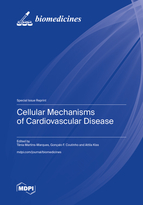Cellular Mechanisms of Cardiovascular Disease
A special issue of Biomedicines (ISSN 2227-9059). This special issue belongs to the section "Cell Biology and Pathology".
Deadline for manuscript submissions: closed (30 November 2022) | Viewed by 52544
Special Issue Editors
Interests: cardiovascular biology; myocardial ischemia; heart failure; intercellular communication; gap junctions; extracellular vesicles; intracellular trafficking
Special Issues, Collections and Topics in MDPI journals
Interests: valvular heart disease; heart failure; coronary artery disease
Special Issues, Collections and Topics in MDPI journals
Interests: vascular biology; pathophysiology of adverse cardiac remodeling; mechanism of myocardial ischemia and reperfusion injury; cardiomyopathies
Special Issues, Collections and Topics in MDPI journals
Special Issue Information
Dear Colleagues,
Cardiovascular diseases (CVD), particularly coronary artery disease (CAD) and stroke, remain the major cause of mortality and disability worldwide. Although cardiovascular outcomes have significantly improved due to early diagnosis and timely treatment, the prevalence of CVD is expected to increase in the coming years, highlighting the pressing need to identify novel biomarkers and disease-modifying treatments. In addition to classical risk factors, CVD burden is now recognized to be aggravated due to the growing population of cancer survivors treated with cardiotoxic cancer therapies or radiotherapy, which has fostered the development of a new field of research—cardio-oncology.
Across the spectrum of CVD, numerous cellular and molecular changes have been reported to occur in both myocytes and non-myocytes, leading to cardiac dysfunction. In fact, multiple molecular pathways converge in cardiac remodeling as well as aorta and mitral valve disease, including cardiomyocyte loss, extracellular matrix alterations, inflammation, oxidative stress, defective calcium homeostasis, intercellular communication, and metabolic abnormalities, which can be associated with a wide range of CVDs with distinct etiologies and clinical manifestations. Therefore, a major future challenge in cardiovascular medicine lies in understanding the molecular basis of cardiac and valvular remodeling, paving the way to the identification of more efficient diagnostic and therapeutic tools.
This Special Issue intends to bring together the latest findings in the field of cardiovascular biology and cardio-oncology, involving both cell-based studies and animal models of CVD aiming to identify novel mechanisms underlying cardiac remodeling and dysfunction.
Dr. Tânia Martins-Marques
Dr. Gonçalo F. Coutinho
Dr. Attila Kiss
Guest Editors
Manuscript Submission Information
Manuscripts should be submitted online at www.mdpi.com by registering and logging in to this website. Once you are registered, click here to go to the submission form. Manuscripts can be submitted until the deadline. All submissions that pass pre-check are peer-reviewed. Accepted papers will be published continuously in the journal (as soon as accepted) and will be listed together on the special issue website. Research articles, review articles as well as short communications are invited. For planned papers, a title and short abstract (about 100 words) can be sent to the Editorial Office for announcement on this website.
Submitted manuscripts should not have been published previously, nor be under consideration for publication elsewhere (except conference proceedings papers). All manuscripts are thoroughly refereed through a single-blind peer-review process. A guide for authors and other relevant information for submission of manuscripts is available on the Instructions for Authors page. Biomedicines is an international peer-reviewed open access monthly journal published by MDPI.
Please visit the Instructions for Authors page before submitting a manuscript. The Article Processing Charge (APC) for publication in this open access journal is 2600 CHF (Swiss Francs). Submitted papers should be well formatted and use good English. Authors may use MDPI's English editing service prior to publication or during author revisions.
Keywords
- inflammation
- oxidative stress
- intercellular communication
- cardiac remodeling
- atherosclerosis
- aorta and mitral valve disease
- myocardial infarction
- cardiac hypertrophy
- heart failure
- cardio-oncology
Related Special Issue
- Cellular Mechanisms of Cardiovascular Disease 2.0 in Biomedicines (6 articles)








